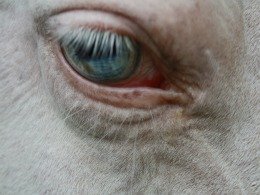






Cremello horses have cream coats with pink skin and blue or glass eyes (cremello is pronounced with emphasis on the penultimate syllable). Their manes and tails are white. The cream colour can vary from a very pale off white to a richer colour resembling a pale gold (like a pale palomino). If they are not white (due to socks or other white markings) the lower legs may be a slightly darker shade than the body.
Cremello horses have a base coat color of chestnut (i.e. of genotype ee, eaea or eea at the extension locus) and are homozygous for the CCr allele at the C locus (the cream dilution gene). Thus chestnut is diluted to a cream colour.
 Cremellos are sometimes called pseudo-albinos. In other animals (including humans) there are recessive alleles at the C locus that cause true albinism. Individuals homozygous for these alleles lack pigment in the hair, skin and eyes. Their eyes and skin are pink (due to the effect of the blood vessels beneath the surface) and albinism is often accompanied by various congenital defects. No true albino horses have ever been observed and presumably they are inviable (i.e. die in utero). The author also notes, from experience, that people often refer to cremellos as being white, although this is not the case.
Cremellos are sometimes called pseudo-albinos. In other animals (including humans) there are recessive alleles at the C locus that cause true albinism. Individuals homozygous for these alleles lack pigment in the hair, skin and eyes. Their eyes and skin are pink (due to the effect of the blood vessels beneath the surface) and albinism is often accompanied by various congenital defects. No true albino horses have ever been observed and presumably they are inviable (i.e. die in utero). The author also notes, from experience, that people often refer to cremellos as being white, although this is not the case.
Palomino enthusiasts might note that the only guaranteed way of producing palomino foals is to breed
chestnut and cremello horses
together. The chestnut should ideally be a red one without dark hairs. It would also be useful to see the cremellos own parents and/or offspring before deciding whether to use it for breeding palomino horses. See the section on palomino horses for more information.
 Cremello horses have traditionally been shunned by some breeders and breed authorities, but are now gaining increased acceptance, thanks in part to the efforts of the Cremello & Perlino Educational Association (CPEA). Their research and campaigning helped to finally get the American Quarter Horse Association’s rule against the registration of “double dilute” horses withdrawn in 2003 (rule 227(i), formerly 227J). Under this rule cremello, perlino and smoky cream foals couldn’t be registered as pure-bred American Quarter horses even if the sire and dam were AQHA registered pure-bred champions with other AQHA registered foals. In the UK The Cremello Society - set up to promote the recognition and appreciation of “double dilute” horses - was officially registered in 2004. The Society provides a registry for all dilute colors, including cremello, perlino and smoky cream, as well as palominos, buckskins and smoky blacks.
Cremello horses have traditionally been shunned by some breeders and breed authorities, but are now gaining increased acceptance, thanks in part to the efforts of the Cremello & Perlino Educational Association (CPEA). Their research and campaigning helped to finally get the American Quarter Horse Association’s rule against the registration of “double dilute” horses withdrawn in 2003 (rule 227(i), formerly 227J). Under this rule cremello, perlino and smoky cream foals couldn’t be registered as pure-bred American Quarter horses even if the sire and dam were AQHA registered pure-bred champions with other AQHA registered foals. In the UK The Cremello Society - set up to promote the recognition and appreciation of “double dilute” horses - was officially registered in 2004. The Society provides a registry for all dilute colors, including cremello, perlino and smoky cream, as well as palominos, buckskins and smoky blacks.












 Cremello horses have traditionally been shunned by some breeders and breed authorities, but are now gaining increased acceptance, thanks in part to the efforts of the Cremello & Perlino Educational Association (CPEA). Their research and campaigning helped to finally get the American Quarter Horse Association’s rule against the registration of “double dilute” horses withdrawn in 2003 (rule 227(i), formerly 227J). Under this rule cremello, perlino and smoky cream foals couldn’t be registered as pure-bred American Quarter horses even if the sire and dam were AQHA registered pure-bred champions with other AQHA registered foals. In the UK The Cremello Society - set up to promote the recognition and appreciation of “double dilute” horses - was officially registered in 2004. The Society provides a registry for all dilute colors, including cremello, perlino and smoky cream, as well as palominos, buckskins and smoky blacks.
Cremello horses have traditionally been shunned by some breeders and breed authorities, but are now gaining increased acceptance, thanks in part to the efforts of the Cremello & Perlino Educational Association (CPEA). Their research and campaigning helped to finally get the American Quarter Horse Association’s rule against the registration of “double dilute” horses withdrawn in 2003 (rule 227(i), formerly 227J). Under this rule cremello, perlino and smoky cream foals couldn’t be registered as pure-bred American Quarter horses even if the sire and dam were AQHA registered pure-bred champions with other AQHA registered foals. In the UK The Cremello Society - set up to promote the recognition and appreciation of “double dilute” horses - was officially registered in 2004. The Society provides a registry for all dilute colors, including cremello, perlino and smoky cream, as well as palominos, buckskins and smoky blacks.
